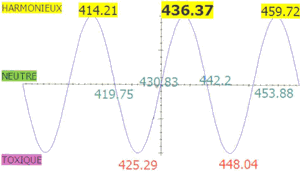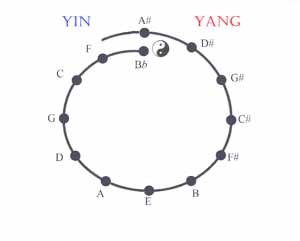Frequency value of the "A" musical note
The whole harmonious universe is based on the golden ratio. What's more natural than the music is also modeled on this number. Currently, the "A" is at 440Hz, but unfortunately we can not find this number as part of a multiple in the golden ratio. The current value of "A" does not seem correct.
Let us try to find the correct value but before that, let's see some definitions:
- Consonance is a set of two or more sounds with the same euphonic affinities, that is to say, pleasant to the ear. The octave, the fifth and the unison are called perfect consonances, and the sixth, the third and the fourth are called imperfect consonances.
- The golden number = 1.618034
- Ratio of frequency interval range respecting the euphony of consonance:
M = major - m = minor
Tonic |
Tone M second |
Thrird m |
Thrird M> |
Forth |
Fifth |
Octave |
C |
D |
Eb (D#) |
E |
F |
G |
C |
1 |
9/8 |
6/5 |
5/4 |
4/3 |
3/2 |
2 |
-
The range consists of seven notes. The current range called temperate, developed by Johann Sebastian Bach consists of 12 equal intervals between two notes in octave. Unfortunately, this simple system is imperfect. There is no balance in ratio of each note leading to a perfect consonance, respecting harmony in the 12 equal intervals as in the system of octaves, fifths and third. Western ear is however accommodated with the time. So there are 12 half tones which is equal to a ratio of 1.059463 (twelfth root of 2).
Calculation of the note "A" harmonious:
We will use the Fifths and the Octaves (that is to say, the perfect consonances) for the calculation. We first search the note whose frequency is closest to the golden ratio. This is the G # -4 = 1.6223. We first apply 2 exponent 6 for Octave to obtain a G # 2 at 103.5542 from a G # -4 fixed at golden ratio (1.618034). Then just applied 4 fifths (4 times 3/2) to obtain E # 0 at 20.455, one fifth down to get the A -1 at 13.638 and rises 5 octaves to get the diapason frequency (A 4) at 436.37644.
Knowing that your harmonic corresponds to 1.0535, a sinusoid of harmonious and disharmonious values (toxic) of the "A" fundamental frequency is obtained. The current "A" is not a lot very harmonious. An instrument set with "A" at 450 give an aggressive music listening fatigue and makes even the listener aggressive.

NOGIER'S 7 Frequencies:
These frequencies were obtained experimentally by the pulsed of light on the areas of the ear and studying the reactivity of the body by changing the pulse (RAC). Note that the RAC due to the change affects the blood, also modifies the reactivity of the muscular system (noticeable by the kinesiology test) but also the impedance can be measured by the MF1 or MF2 biofeedback device position (based on the principle of amplification of the impedance variation).
The frequencies obtained are as follows:
A |
B |
C |
D |
E |
F |
G |
2.5 |
5 |
10 |
20 |
40 |
80 |
160 |
He found (like musical notes in the case of octaves) that doubling G, he got again A. The D stands for harmony. Frequencies A, B, C correspond to the Yin and E, F, G to Yang.
7 fundamental frequencies of NOGIER modified will therefore based on the E note:
A |
B |
C |
D |
E |
F |
G |
2.56 |
5.11 |
10.23 |
20.46 |
40.91 |
81.82 |
163.64 |
7 frequencies and their harmonics:
A |
B |
C |
D |
E |
F |
G |
0.02 |
0.04 |
0.08 |
0.16 |
0.32 |
0.64 |
1.28 |
2.56 |
5.11 |
10.23 |
20.46 |
40.91 |
81.82 |
163.64 |
327.28 |
654.56 |
1309.13 |
2618.26 |
5236.52 |
10473.03 |
20946.07 |
Spiral of fifths:
To respect the system of consonances, we must differentiate the note Bb and A# and put into the spirals form and not in circular form. By placing the E down, since it corresponds to the physiological balance that we see in the light of the NOGIER work, and calculating on the basis of fifths, we obtain:

Thanks to the work of Gerard FICHES and of these calculations and the ensuing adjustments. These components have been added to the Software for frequency medicine database, so that you can enjoy it directly without having to enter them manually. It is free for you to use or not following your opinions.
Although his methods are not scientifically rigorous than his calculations, however, we may consider some of his correspondences:
Stone |
Organ
12 méridians |
Planet |
Brain |
Note |
Agate |
small intestine |
Saturn |
Thalamus, Diencephalon |
B |
Amber |
Kidnez |
Uranus |
Rhinencephalon |
F |
Amethyst |
Splain |
Neptune |
Hippocampus |
G |
Carnelian |
Heart |
Earth |
Hypothalamus |
D |
Diamond |
Adrenal, Triple burner |
Sun |
Epiphysis |
E |
Emerald |
Liver |
Moon |
pituitary |
G# |
Jasper |
Pericardium |
Jupiter |
Trine,frontal lobe |
C |
Ruby |
Lung |
Asteroïds |
Under Cortex |
F# |
Blue Sapphire |
Stomach |
March |
Cortex |
D# |
Yellow Sapphire |
Adrenal
Triple burner |
Sun |
Epiphysis,canvas upper choroidal |
E
(20.45) |
Sard |
Gallbladder |
Mercury |
Habenula |
C# |
Yellow Topaz |
Large intestine |
Venus |
Posterior white commissure |
A |
Turquoise |
Bladder |
Pluto |
anterior white commissure |
A# et Bb |
Color |
Note |
Yellow |
E |
Yellow-green |
B |
Green |
F# (Gb) |
Dark green |
Db (C#) |
Blue |
Ab (G#) |
Violet |
Eb (D#) |
Mallow |
Bb |
Carmen red |
F |
Dark red |
C |
Red |
G |
Orange-red |
D |
Orange |
A |
For RNA: Guanine (A), Adenine (C), DNA (A), thymine (E), Cytosine (G)
Specificity for RNA: Uracil (E), RNA (D)
Correspondences set for the following agreements are based on the note E seat physiological balance, and not on the C note (musical convention).
Major triads:
C Major
C E G |
G Major
G B D |
D Major
D F# A |
A Major
A C# E |
E Major
E G# B |
Si Major
Si Ré# Fa# |
F# Major
F# A# C# |
C# Major
C# E#(F) G# |
G# Major
G
l# B D# |
F Major
F A C |
Bb Major
Bb D F
A# Major
A# D F |
Bb Major
Eb(D#) G Bb
D# Major
D# G Bb |
Minor triads:
C Minor
C Eb (D#) G |
G Minor
G Bb D |
D Minor
D F A |
A Minor
A C E |
E Minor
E G B |
B Minor
B D F# |
F# Minor
F# A C# |
C# Minor
C# E G# |
G# Minor
G# B D# |
F Minor
F Ab(G#) C |
Bb Minor
Bb Db(C#) F
A# Minor
A# C# F |
Eb Minor
Eb(D#) Gb(F#) Bb
D# Minor
D# F# Bb |
The Bb is differentiated from the A# physiology, so we obtain 13 major tunes and 13 Minor tunes.
Example of Application to cancerous cells by Gerard FICHES:
Stem cells vibrate at a harmonious accord in Bb minor (Bb C # F). Cancer cells vibrate at a toxic accord: Bb C # F #. Metastases vibrate toxic accord: Bb D G.
If we refer to other works on the following correspondence with the elements:
Earth E, Metal: D, Water: G Wood: C Fire: A. E represents the center as in the case of NOGIER frequencies.